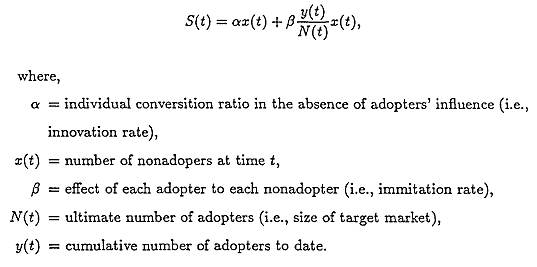
II. PRIOR RESEARCHES
1. Bass Model and Critics
Subsuming the models proposed by Fourt and Woodlock( 1960) and Mans-field(1961), the Bass model(1969) assumes that potential adopters are influenced by two means of communication - mass media and word-of-mouth. In its developments, it further assumes that the adopters of an innovation comprise two groups. One group, innovators, is influenced by the mass media communication(external influence) and the other group, imitators, is influenced only by the word-of-mouth communication(internal influence).

Since its introduction to marketing, many scholars from related fields extended or refined original Bass model. But, Bass model receives considerable critics because of its strict assumptions. This section describes the critics about Bass model and its extensions which attempt to resolve these critics.
(1) The applicability of Bass model is limited to newly launched product at the growth stage only, i.e., "... suited to the rapid growth stage with relative absence of successful forecasting models for the maturity and decline stages(Day 1981)." The models developed by Dodson and Muller(1978), Lilien et al.(1981) and Hahn et al.(1990) address the issue of a repeat-purchasing behavior of nondurables in a diffusion framework. Repeat-purchasing behavior of durables(i.e., replacement-purchasing behavior) was studied by Harrell and Taylor(1981), Lawrence and Lawton(1981), Olson and Choi(1985), and Kamakura and Balasubramanian(1987). Detailed description of replacement demand will be given in III.2. REPLACEMENT-SALES SUBMODEL.
(2) Marketer-controlled variables are not explicitly included in a diffusion framework. Dolan and Jeuland(1981) and Bass(1980) included the impact of price in the diffusion model; Lilien et al.(1981) presents a model incorporating detailing effort; the papers by Horsky and Simon(1983), Simon and Sebastian(1987), Dockner and Jorgensen(1988) and Horsky and Mate(1988) incorporate advertising in new product innovation; Kalish( 1982) integrates several of these effects.
(3) The number of potential customers is assumed fixed over time. Several researchers, such as Mahajan and Peterson(1978), Meade(1985, 1988) and Kamakura and Balasubramanian(1987) have shown how a time-varying
adopter population can be accommodated into such a modeling framework. The rationale of incorporating time-varying saturation level and mathematical representation of the assumptions of market potential will be described in II.2. TIME-VARYING SATURATION LEVEL.
(4) The diffusion parameters are assumed constant over time. This critics can be validated by research of Heeler and Hustad(1983). Horsky and Simon(1983), Robinson and Lakhani(1975), and Bass(1980) have relaxed this assumption. As many researchers implied, dynamic diffusion parameters are interrelated with marketing mix variables. Thus, we need to combine marketer controls and time-varying diffusion parameters in one plausible framework. Description of this work will be given in II.3. MARKETER-CONTROLS.
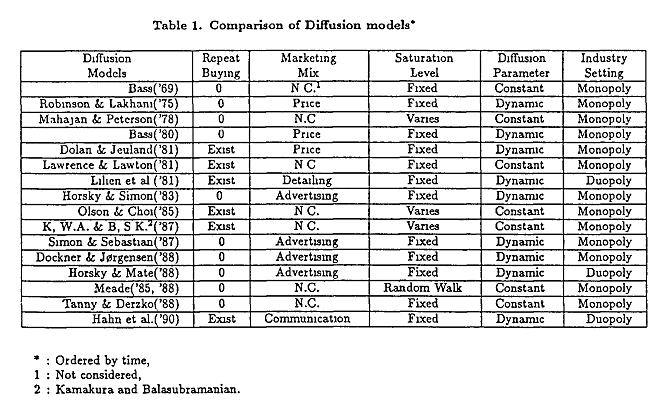
(5) Bass(1969) developed his model based on monopoly. If the main interest of a diffusion model is to model company sales, this assumption need to be relaxed. Dodson and Muller(1978) suggest the possibility of incorporating competition. Lilien et al.(1981), Horsky and Mate(1988), and Hahn et al.(1990) have addressed this issue. See II.3. MARKETER-CONTROLS.
Table I summarizes previously cited diffusion models.
2. Time-Varying Saturation Level
If managers want to assess and forecast demand, the most important and difficult answer, they must resolve, is target market size, N(t), the greatest amount of that could be sold under given environmental conditions(Lilien and Kotler 1983, Mahajan et al. 1990, etc). Any models aimed at evaluation and forecasting sales are very sensitive to misspecifying market potential (Mahajan and Muller 1979, Lilien et al. 1981, Lilien and Kotler 1983, etc).
In order to determine total market size, we need to integrate several factors such as, (1) the number of populations, (2) usage rate, (3) the level of income, and (4) the price.
Before describing methodologies of specifying dynamic market size, it is worthwhile to examine a controversy about the impact of price on a diffusion rate.
Some authors(Robinson and Lakhani 1975, Bass 1980, Dolan and Jeuland 1981) argue that a price decrease could engender an increase in the probability of adoption. Hence, a price reduction would only motivate potential buyers to make an earlier adoption, with no impact on the market potential.
On the contrary) other researchers(Chow 1967, Mahajan and Peterson 1978, Horsky and Simon 1983) Kamakura and Balasubramanian 1987), assert equally convincingly, that a lower price would place the product within the budget limitations of a greater number of buyers, thus affecting the market potential for the product.
Attempts by Mahajan and Peterson(1978), Olson and Choi(1985), Kamakura and Balasubramanian(1987), and Meade(1985, 1988) give some insights how to incorporate time-varying saturation level in a diffusion framework, which are summarized in table 2.
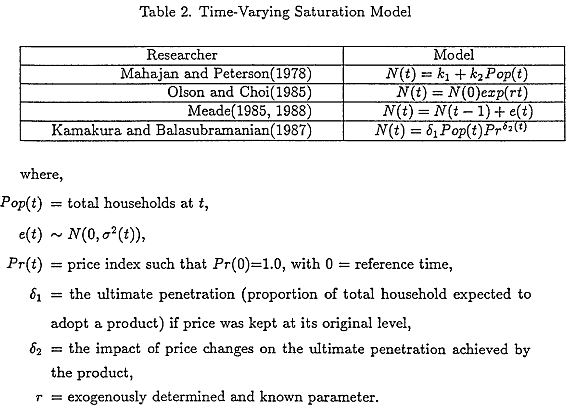
Another approach, which is oftenly utilized method by managers(Hughes 1973, Lilien and Kotler 1983), is decomposition principle. Being also called as a chain ratio method, basic strategy of this approach is (1) to decompose each problem into as many parts as were relevant to the answer and could be managed in a reasonable amount of time, (2) to make the parts of roughly equal importance to the answer, (3) to select parts about which there are relatively good general information, and (4) to be sure that the final answer could be obtained from the parts by simple, arithmetic operations(Armstrong et al. 1975).
3. Competition
This section introduces methodologies how interfirm and intrafirm intractions of marketing efforts could be modeled in a diffusion and replacement framework. Though the importance of these structural relationships, whether in a diffusion framework or not, has certainly been recognized, very few empirical studies have included all of them concurrently. For example, numerous studies have analyzed the effect of one marketing variable, especially advertising on product sales(Sethi 1977, Little 1979). The main reason for such an approach is probably the lack of good data. Unfortunately, failure to include the relationships among certain variables may result in severe model misspecification and, ultimately, unreliable research findings(Hanssens 1980).
Research by Dodson. and Muller(1978) might be the first attempt which incoporates competition in a diffusion framework) but they gave no analyzible model.
Lilien et al.(1981) presented a model which incorporate competitive nature of detailing effectiveness into an ethical drug adoption process. This may be the simplest model which consider competition.
With an normative objective of optimal control of advertising spending rate, Horsky and Mate(1988) formulated the competition between two firms as a two-player, non-zero sum Markovian game.
Hahn et al.(1990) presented a parsimonious new product model that can be used to forecast sales of a frequently purchased product in the early stage of the product life cycle. Their specification of the competitive nature of marketing efforts is;
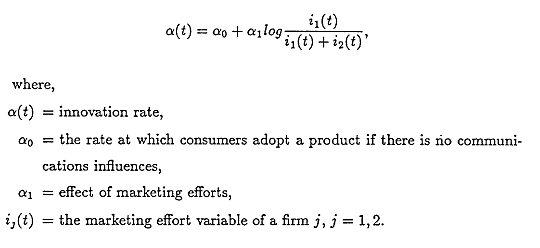
Another important contributions deserve close attention are researches of Lambin et al.(1975) and Hanssens(1980), although they did not study in a diffusion framework. With a lack of the studies about diffusion process synthesizing (1) sales response to marketing efforts, (2) feedback of sales to marketing expenditures, (3) interactive nature of marketing mix variables, and (4) competitive behavior, their insights may help formulate the above phenomena.
Except for distinction between primary and secondary demand) their framework can be illustrated by a simple example. Suppose that there are two firms in a market, and they use only two marketing tools - price and advertising. Then, the matrix of reaction elasticities R is
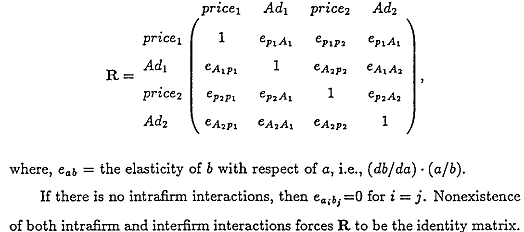
Another reason, reviewing the model proposed by Lambin et al.(1975), Hanssens(1980), is that these models explicitly includes intrafirm interactions of marketing variables. The marketing literature cites many instances of that "intrafirm effect" such as, the negative relationship between advertising and personal selling or the positive relationship between price and personal selling. As a result, numerous researchers have faced problems in estimating sales response coefficients because of serial correlations in marketing mix variables(Houston and Weiss 1975, Heskett 1976).
다음 페이지로